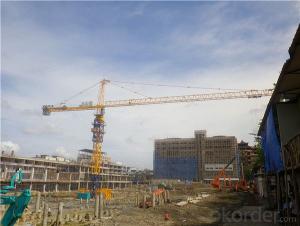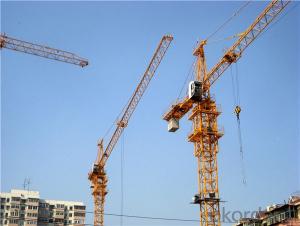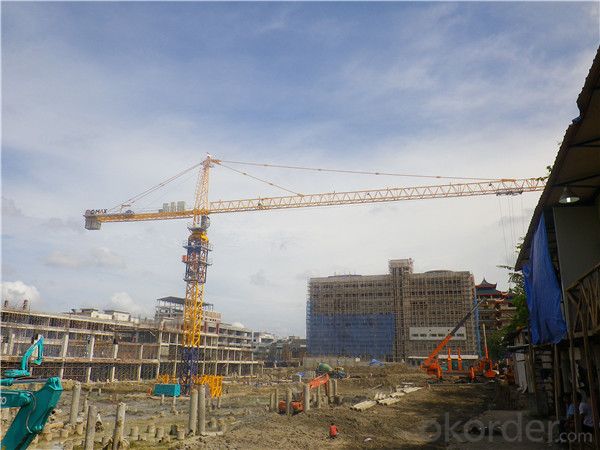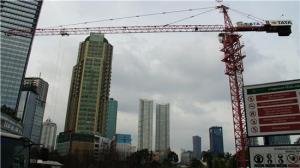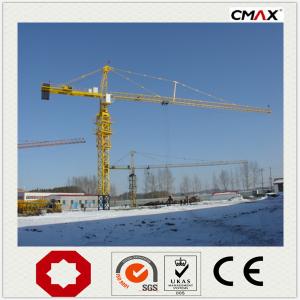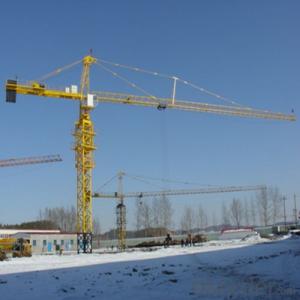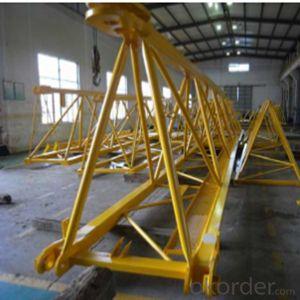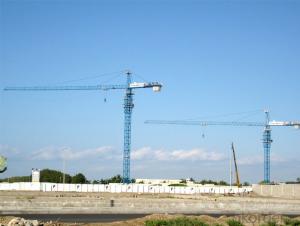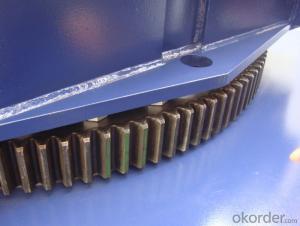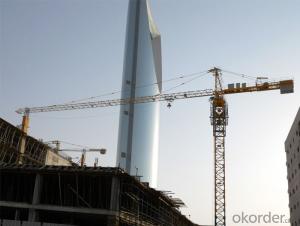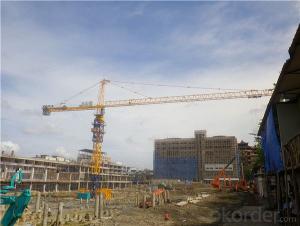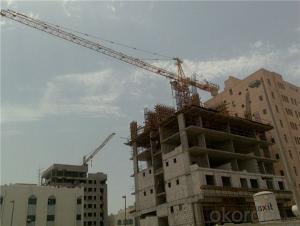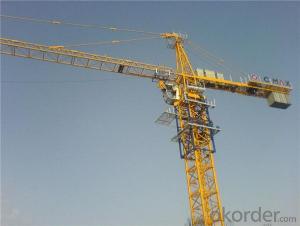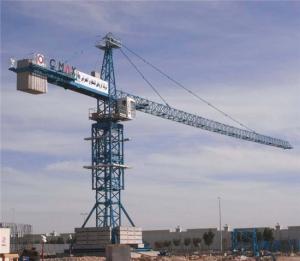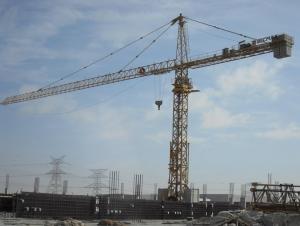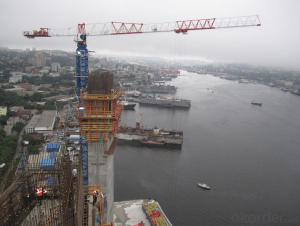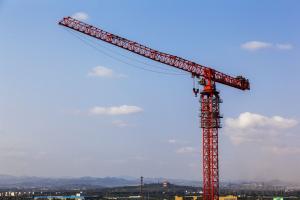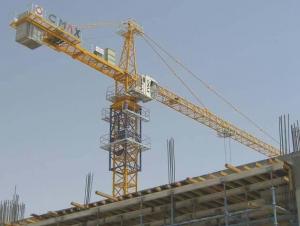Luffing Tower Crane TC 5511 for Construction
- Loading Port:
- China main port
- Payment Terms:
- TT OR LC
- Min Order Qty:
- 1 set
- Supply Capability:
- 20 set/month
OKorder Service Pledge
OKorder Financial Service
You Might Also Like
Description of our Tower Crane
1, TC4808 have competitive price and excellent quality, suitable for all kinds of construction project and can work under all kinds of work condition. With their working radius from 2.25 to 48m, TC4808 tower cranes are famous for their large operating ranges, varied working methods and wide uses.
2,This series of tower cranes has a horizontal jib frame, a jib-trolley radius-changing mechanism and a hydraulic self-raising mechanism.
3, It is original in design, reliable in operation and satisfactory in shape.
4,Equipped with all necessary safety devices, these cranes show a good speed-control capacity,, satisfactory operating stability and high work efficiency.
5,They are widely applied for the construction of high-rise hotels, resident buildings, high-rise industrial buildings, large-span factory buildings and tower like buildings like tall chimneys. Best after sales service will be offered which will get rid of all your worries in the purchase of our products
Advantage of our tower crane
1, boom relief Angle is big, greatly widened the equipment capacity and scope of work.
2, suitable for the group of tower cross homework.
3, boom stability is good, combination amplitude range.
4, suitable for height have special requirements occasions construction.
5, lifting capacity big, effectively solve the high steel structure construction team crane big lifting capacity requirements.
Specification of Tower Crane
Model | QTP80 (TC5511) (Flat-Top) |
Max Working Radius (m) | 55 |
Free Height (m) | 41 |
Max Load (T) | 6 |
Tip Load (T) | 1.1 |
Max Height (m) | 161 |
Wall Ties for Max Height (sets) | 8 |
Main Material Specs (mm) | Square Steel Tube 1352*12 |
Mast Section Dimension (m) | 1.835*1.835*2.5 |
Hoisting Speed (m/min) | 80/40/10 |
Min Steady Falling Speed (m/min) | 5 |
Slewing Speed (r/min) | 0-0.62 |
Radius-changing Speed (m/min) | 40/20 |
Jacking-up Speed (m/min) | 0.6 |
Total Motor Power (kw) | 60 |
Independent Structure Weight (kg) | 37800 |
Counter Weight (T) | 16.2 |
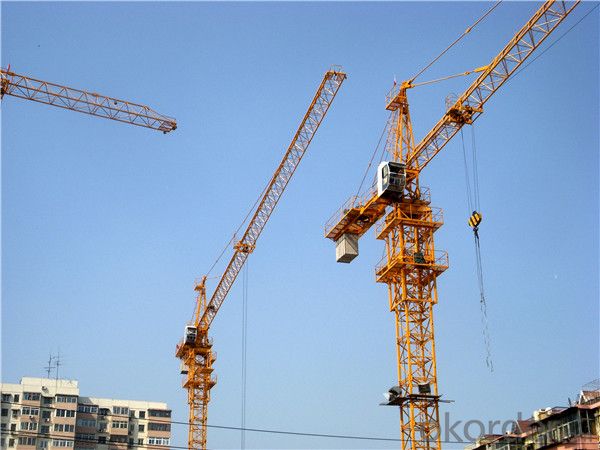
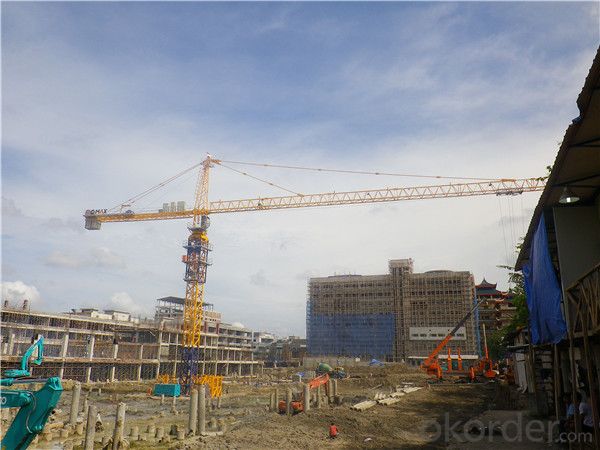
- Q: OMG! a phoba of crane flys, and there are 5 on my celling right now!!! What do I do, will the move and fly around eventually? I can't kill them, they are out of my reach, and if they start moving, im runing the %^$ outta my house.Will they die by tommorow? or will they just hang there?
- You !!!!!!!!!!!!!!!! that made me jump, i hate spiders... But they do say they are good for keeping the flys down...Personally i use a spray or a fly swatter, the swatter is great because it gives them an electric shock and kills them straight away.
- Q: i know something is supposed to happen when you make a thousand origami cranes but i dint remember what happens. can someone please help me
- An ancient Japanese legend promises that anyone who folds a thousand origami cranes will be granted a wish by a crane, such as long life or recovery from illness or injury. via Wikipedia Can also be a wedding gift to wish good luck and happiness for the newlyweds. Hope this helps!
- Q: my father is owning a crane manufacturing business I hav given my ssc wat should I study after ssc IT, mechanical engg., design engg. and others (plz. specify) ?
- Without being too critical, the first thing you need to do is improve your English so that you will be a huge help in the company whether in engineering or sales. Cranes require lots of engineering in weight handling (mechanical), automation and controls including instrumentation (electrical) and a tertiary field in engineering is in stopping and starting (clutches and brakes) which can be mechanical or hydraulic engineering. A new filed is metalurgy which is concerned with the way metals perform (stress), lighter,stronger, etc. Take your choice. Mpho
- Q: Well,i just LOVE this piece of origami work...I've tried so many (kinda the same) instructions but i always get confused on the step 3-4...do you know any easy instruction,with clear explanations for a begginer?thank you already~~
- visit okorder / that's the place where I learned folding paper cranes. XD I've always loved them.
- Q: where does it live? what does it eat? How do you feel about it? (positive side)thank you! thank you! thank you!help!help!help!
- In the spring and summer, the Red-crowned Crane breeds in Siberia and occasionally in northeastern Mongolia (i.e., Mongol Daguur Strictly Protected Area). Normally the crane lays 2 eggs, with only one surviving. Later, in the fall, it migrates in flocks to Korea, Japan, China, Taiwan, and other countries in East Asia to spend the winter. All Red-crowned Cranes migrate, except for a flock that is resident in Hokkaidō.
- Q: First Summary gets best answer...thanks!
- Manslaughter charges come about when it involves death, caused by negligence on someone's part - either the operator, the owner of the crane, the contract, etc.
- Q: The story I'm writing that has Frank Crane in it is here. Is there a better name I could be using for the protagonist?
- I just read your skimmed through your story very quickly. His personality from what I got from the story seemed to fit the name Frank Crane very well. I like the name for that character. Not sure what other name options you have in mind though, maybe you should post some other naming options. BTW, cool story.
- Q: Could anyone tell me how they erect a construction crane.Some how they just are suddenly THERE, as If by magic.It seems as though the Boom part of the crane must be kind of JACKED up into place.That is the only way I can see them getting those GIANT concrete blocks into the back end of the boom. It doesn't seem possible otherwise. The only other thing I can thing of is the bulk of the pieces are brought in by helicoper and attached.Everything kind of makes sence except the Giant concrete blocks used as a counter weight. ALSO, if the blocks are needed to act as counterweigth to the CRANE itself..why doesn't the Crane fall over when it picks stuff up???
- How do they erect the construction cranes? Not very well according to the news of them toppling down of late. Seriously, the cranes are lifted upward one or two floors at a time as the building progresses upward - this is usually accomplished by pulling them up into place with heavy cables and powered winches.
- Q: What role does the tower crane torque limiter play?
- The overload protection of tower crane is protected by two equipment, lifting load limiter and torque limiter. The latter generally in the big arm root 4-5 meters to the front of the large arm, overloading (Chao Liju) work, it is more important, basically, the scope of work is torque limiter plays a protective role. While the former is the weight limiter function in the arm root within 4-5 meters, because the tower crane is a jib type crane, each allowing weight lifting position corresponding to the different (CAB load curve). For example, such as 63KN.M, the big arm root 2 meters lifting, the theory is 23 tons, while the torque limiter is not over, but in fact, the tower crane at early crouched down, so the weight limiter in this work.
- Q: how to calculate load capacity of crane?
- Very complicated - strength of boom and tower, angle of boom and thus distance of load from base, size and position of counterweight, location of support arms. A specific crane may have different capacities depending on whether an extension boom is used (reaching higher and farther out with a reduced load)
Send your message to us
Luffing Tower Crane TC 5511 for Construction
- Loading Port:
- China main port
- Payment Terms:
- TT OR LC
- Min Order Qty:
- 1 set
- Supply Capability:
- 20 set/month
OKorder Service Pledge
OKorder Financial Service
Similar products
Hot products
Hot Searches
Related keywords
